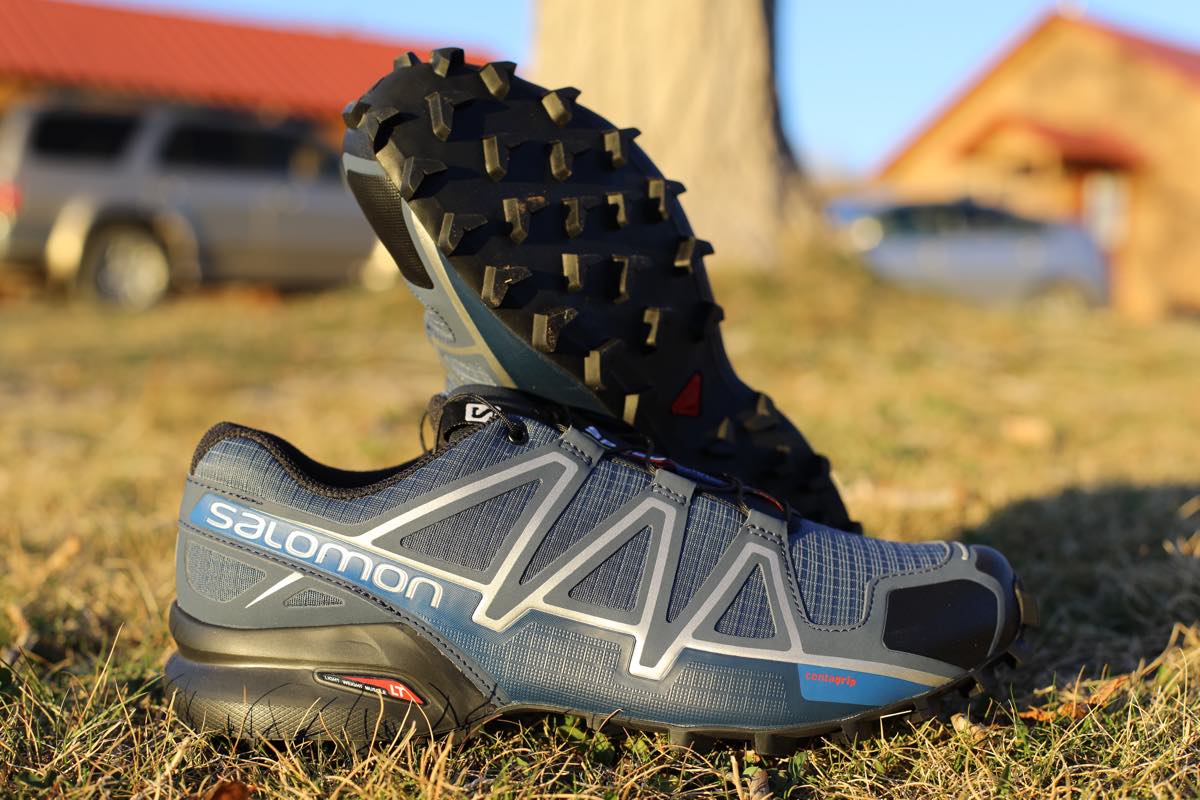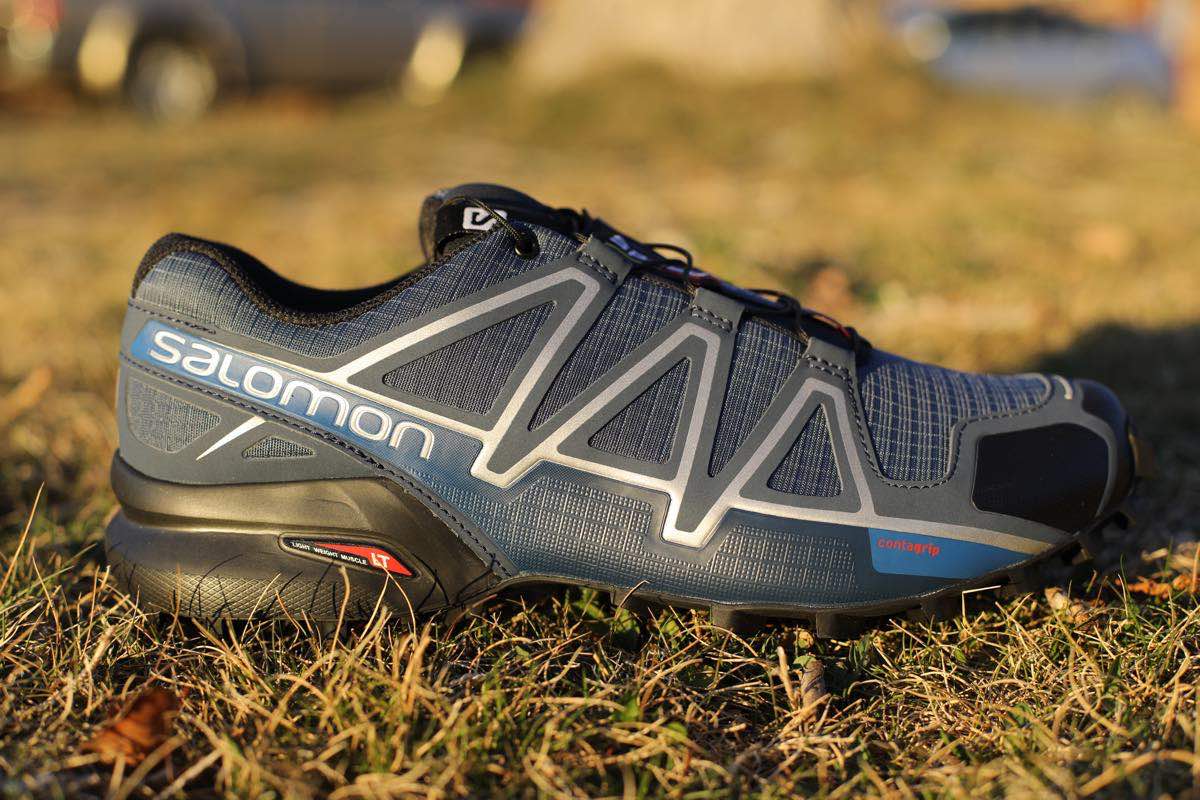For the latest on the Speedcross family, check out our Salomon Speedcross 6 review.
Our Favorite Trail Running Shoes
To learn about our current favorite trail running shoes, check out our Best Trail Running Shoes article.
Salomon Speedcross 4 Review
Mud season is here for many places in the Northern Hemisphere—the bracing and lovely ‘sprinter’ season (spring and winter) where massive snow dumps can occur right along side atmospheric rivers in the Pacific Northwest and eighties Fahrenheit near Phoenix, Arizona. Colorado prefers to put all those (minus the pouring rain) in a few days with a good dose of Nebraska-style blow-you-sideways winds. I can try out shoes in all four seasons in a few days!
Luckily, this time around I was testing one of my long-time favorite trail running shoes—the Salomon Speedcross 4 ($130). The Speedcross is a love-it-or-leave-it shoe for many people. So while I never like to see a favorite shoe of mine undergo changes, for the most part, I like the refinement they’ve done with this fourth rendition. I’ve had many, many pairs of Speedcross since the original one came out, and I’ve loved every one—they make me feel fast and relatively agile, and they handle a lot of difficult terrain well. Read on to see what I really like about the 4 and what might leave a bit to improve next time.
Salomon Speedcross 4 Upper
The upper remains unchanged for the most part—same great toe bumper, mud-guard rand, textiles, and overlays. I found the shape and width to feel the same on my foot as prior models have in the same size (women’s 8.5)—it’s the snug, soccer-boot fit that leaves me just enough room to wiggle my toes, but not much extra. In all my other footwear, I seek out very roomy toeboxes, but for some reason, the Speedcross still works even for my Chaco-loving foot. The durable anti-debris mesh remains rather water resistant in the regular shoe, and there is a Speedcross 4 GTX as well as a Speedcross 4 CS (ClimaShield) option for those who prefer even more protection against the elements.
I find the upper to truly excel at keeping debris out. Coupled with a pair of Dirty Girl gaiters, I’m always surprised at how clean my feet end up after a burly day in the mountains. For as good as the mesh is at keeping stuff out, it does tend to retain a bit of water after a few soakings in streams. It doesn’t end up bothering me or creating blisters, but if they could magically improve the drying rate of the shoe, I’d not be disappointed. I don’t find heat retention to be an issue for me with Speedcross in the summer, but I don’t live in the truly hot and humid environments that many do, so I’d be interested to hear your thoughts.
The tongue is still not gusseted but is adeptly held in place by the thin ribbon that runs up the center of the tongue from distal to proximal, which also acts as another layer of protection for your foot from the Quicklaces. The lace garage is still on the end of the well-padded tongue and it’s perfectly placed to accept the laces after I cinch them. I find it just as easy to route the tail back under the far-end horizontal lace. I do love Salomon’s Quicklaces; I’ve never preferred any other brand’s version of the same concept. These are set-it-and-forget-it laces for me on this shoe and they neither tighten nor loosen during a run of any length. That’s pretty amazing to me.
Lastly, Salomon points out that some changes were made to the heel collar and ankle notches of this fourth rendition, making them slightly lower profile but with improved padding. To be honest, I didn’t notice significant differences here compared to past versions I’ve owned. What I can say is that the ankle notches do not contact my lateral or medial malleoli at all in an uncomfortable manner. I’m thankful for this as it’s not true in all types of shoes. My Achilles is quite happy running up and down various types of inclines and declines in the Speedcross 4, which means the Achilles notch in the firm heel cup is also still thoughtfully well-designed. All in all, the changes here are subtle in my experience and certainly haven’t taken away at all from the Speedcross line.
Salomon Speedcross 4 Midsole
No significant changes were made to the midsole of the Speedcross 4. Both molded and injected EVA are utilized to allow for relatively lightweight cushioning and stability. Salomon’s website has the weight at 300 grams and the stack height at 30mm in the heel and 20mm in the forefoot for a 10mm drop, which is in the same range as it’s been. Some other websites list the drop at 11mm, but I’ll go with the brand’s official listing to keep it consistent. This drop is definitely in my happy zone, and I really appreciate it as the miles rack up. The biggest challenge I have with the midsole is how thin the forefoot feels in the later miles of a technical 50k or a mountain 50 miler. I have long wished they would add a rock film (or even a thin rock plate) to the forefoot for a bit more protection in between the lugs, but so much else is right about the shoe, it hasn’t stopped me from wearing them. The other point of difficulty for some people I know, is the overall height of the shoe. At 30mm/20mm, you’re up off the ground a ways compared to other shoes in the same category, which causes some tipping and rolling of ankles for those who prefer a lower-to-the-ground shoe. I haven’t had any issues with that myself and still favor the protection and traction offered from midsole and outsole they’ve chosen a good portion of the time.
The OrthoLite insole is again included, which I love because of the added cushioning and arch support it provides. The foam includes recycled-tire content, which is a nice nod to the environment, and it’s amazingly durable over the miles. I find that it fits very securely within the shoe no matter the weather and conditions I run in. It’s always dry by the next day’s run even if the prior run was several hours in the snow. The EVA heel cup on the sock liner helps support my heel a bit better in the Speedcross 4 and adds a bit of cushioning around it, which certainly enhances comfort as the miles pile up. For my foot, this insole is one of the best, and I’ve taken it out and used in other shoes before to extend their wear.
Salomon Speedcross 4 Outsole
The outsole of the Salomon Speedcross 4 is upgraded to a more dense and durable version of the Premium Wet Traction Contagrip. The chevrons have the same appearance but are slightly smaller and placed with a higher density on the outsole. Gone are the half-chevrons that were around the outline of the sole, which should definitely lead to fewer ripped off outer lugs, an occasional complaint. I’m noticing very little wear on my outsole of the tester shoes after 125 miles, but more impressively, I’d been wearing a pair I’d bought several months prior in my regular shoe rotation, and again, the outsole has very little wear at 250-plus miles. It seems as if the increased density of the chevrons also is making the wear pattern more even so the shoe sits just as flat as ever against the ground. I’m excited to see how these hold up as summer Rocky Mountain running rolls around again. As a side note, when I lived in the Pacific Northwest, I felt like these shoes were genuinely even more in their element with the softer ground underfoot and the different types of debris. The traction these held over the sloppiest mud and undergrowth was impressive, and I can sincerely recommend to anyone living in wet, forested areas as well.
As is typical of the Speedcross, the traction is amazing on all the technical surfaces I run. It’s overkill for gravel roads and smooth singletrack—there are plenty of other shoes out there for those surfaces. It’s the shoe I pull out for snow runs when I don’t quite need Kahtoola Microspikes, and it’s one of the ones I most commonly wear for more rocky and rubbly trails in our mountains. It sheds all but the worst clay mud with ease, and I feel confident ascending and descending on trails with rocks of all types—talus, scree, doll heads, ball bearings—well, as confident as I could feel in my less-than-graceful downhilling. Some have noted that the traction on wet rocks leaves a little to be desired, but I’d say that’s true for me with all shoes. The Speedcross 4 is what I feel most confident in for such conditions at this point, but another brand or two is now coming in a very close second—a rising tide lifts all boats, do they say? All in all, the outsole of the Salomon Speedcross 4 is one of the best in the business for mountain running for me.
Salomon Speedcross 4 Overall Impressions
The Salomon Speedcross 4 remains one of my favorite shoes for mountain running in most types of environments. For my feet, the Speedcross line is tested and proven over thousands of technical miles, and what shortcomings the shoe has, I know and understand and am able to work around. If you can tolerate the soccer-boot style of fit for the distances you’re doing on mountainous and technical terrain and don’t mind the higher profile, the Salomon Speedcross 4 is definitely worth a trial. Enjoy the agile responsiveness as you adventure through your favorite technical terrain!
Other Versions of the Salomon Speedcross 4
While we reviewed the men’s Salomon Speedcross 4 in this article, be sure to also check out the Salomon Speedcross 4 women’s version.
Also, you might be interested in the waterproof edition of this shoe: the Salomon Speedcross 4 GTX men’s version and Salomon Speedcross 4 GTX women’s version.
Call for Comments (from Meghan)
- Are you a Salomon Speedcross wearer? If so what do you think of the changes and updates to version 4? Have they been improvements for you?
- If you’re a Speedcross wearer, what features of the shoe do you most appreciate and what types of terrain do you think they travel best on?
[Editor’s Note: If you’re affiliated (i.e., an employee, ambassador, etc.) with a shoe brand, please share your relation in each of your comments on this article. Thanks!]





